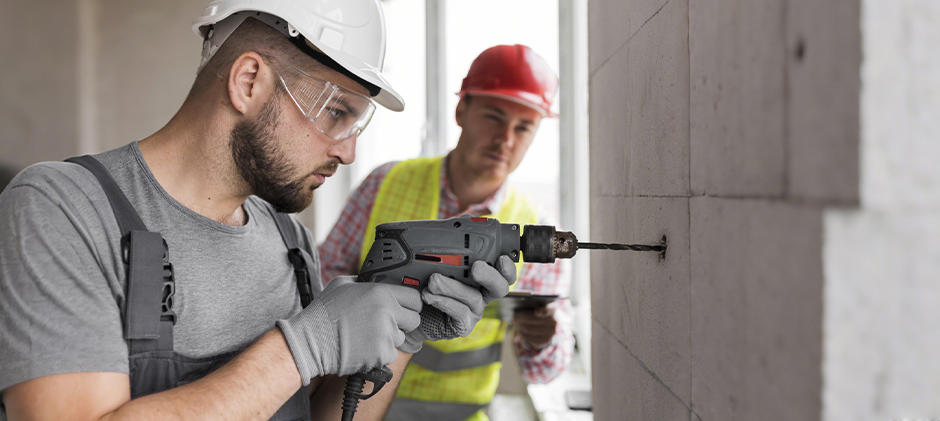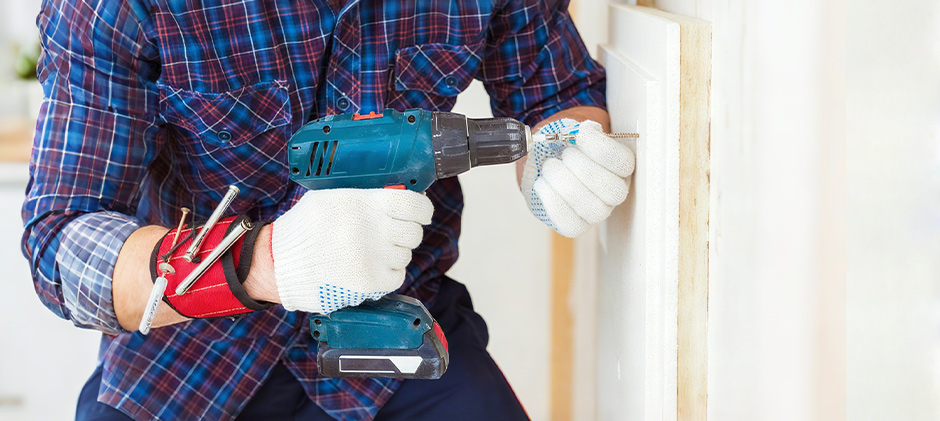It may cause serious damage to materials, broken bits, and a lot of frustration, and more if you confuse hammer drill vs impact driver. So what is the difference between a hammer drill and an impact driver? One word to say, the former is for drilling holes, and the latter is for drilling screws. For more detailed differences, follow me to read the rest article.
Hammer Drill vs Impact Driver: Key Differences
| Feature | Hammer Drill | Impact Driver |
|---|---|---|
| Main Use | Drilling into hard materials (concrete, brick) | Driving screws and fasteners with high torque |
| Power Delivery | Fast, linear (forward-and-back) blows | Fast, rotational (sideways) bursts |
| Primary Motion | Rotation + Forward Hammering | High-Torque Rotation |
| Best For | Making holes in masonry | Driving long screws fast |
| Bits | Standard round-shank or SDS bits | Hex-shank bits only |
| Noise | Loud, percussive hammering (~88 dB) | Very loud, rotational chattering (~100+ dB) |
What Is A Hammer Drill?
A hammer drill is a powerful drill with an added function: it punches forward as it spins. Think of it as a regular drill combined with a tiny, rapid-fire hammer, designed to pulverize hard materials like concrete and brick.
How Does A Hammer Drill Work?
A hammer drill uses a mechanism with two rigid discs. When in hammer mode, these discs spin against each other and ride up and over the ridges, creating a rapid series of linear (forward-and-back) impacts. This hammering action chips away at masonry, allowing the rotating drill bit to clear out the debris and create a hole. As one user aptly described it, imagine holding a chisel and hammering it into wood—that’s the direction of force a hammer drill applies. Most models have a switch to turn this function off, allowing them to work as a standard drill/driver.
What Is A Hammer Drill Used For?
- Drilling holes in concrete, brick, stone, and mortar.
- Installing anchors for shelving or fixtures on masonry walls.
- Any drilling task that requires breaking through very hard surfaces.
How to Use A Hammer Drill
Insert a masonry bit into the chuck. Switch the tool to “hammer mode” (usually marked with a hammer icon). Apply firm, steady forward pressure and pull the trigger. Let the tool’s hammering action do the hard work of breaking through the material. For very hard concrete, it helps to start with a smaller pilot hole.

What Is An Impact Driver?
An impact driver is a specialized, high-torque tool designed for one primary job: driving screws and tightening bolts with incredible efficiency. It’s the expert fastener-driver in your toolkit.
How Does An Impact Driver Work?
When an impact driver senses resistance (like when a screw gets tight), it engages an internal hammer and anvil mechanism. This delivers powerful rotational (sideways) impacts to the bit.
ChatGPT said: These impacting forces are generating huge torque to drive the fastener through very dense material, and an important point is, the force is delivered into the screw body, not returned into your wrist part. This is why you feel less strain and kickback compared to a drill when driving large fasteners.
What Is An Impact Driver Used For?
- Driving long screws for framing or building a deck.
- Working with large fasteners like lag bolts.
- Assembling and disassembling machinery.
- Removing stubborn, over-tightened, or rusted bolts.
How to Use An Impact Driver
Secure a hex-shank bit into the quick-release collet. Press the tool firmly against the screw head and apply a slow, steady trigger pull to start. As the screw tightens, the impacts will kick in automatically. There’s no need to push hard; let the tool do the work.

Can You Use a Hammer Drill as an Impact Driver?
No, this is not recommended. A hammer drill’s forward hammering action is designed to break up concrete, not to help turn a screw. Using it to drive a fastener will, at best, do nothing useful and, at worst, damage the screw head or the surface you are working on. The two impact mechanisms apply force in completely different directions and are not interchangeable.
When to Use a Hammer Drill vs an Impact Driver
| When to Use a Hammer Drill | When to Use an Impact Driver |
|---|---|
| Drilling holes in concrete walls | Driving hundreds of deck screws |
| Installing anchors in a brick fireplace | Assembling a wooden playset |
| Making a hole in a stone paver | Fastening lag bolts into a support beam |
| Any project requiring holes in masonry | Removing stubborn bolts from an engine |
Impact Driver Vs Hammer Drill: Pros and Cons
Hammer Drill Pros
- Excellent for drilling into hard materials
- Versatile (can be used as a regular drill)
- Accepts a wide range of drill bits
Hammer Drill Cons
- Heavier and bulkier than standard drills
- Loud and creates significant vibration
- Not ideal for driving screws without a good clutch
Impact Driver Pros
- Delivers massive torque for fasteners
- Reduces user strain and kickback
- Compact, lightweight, and easy to handle
Impact Driver Cons
- Not designed for drilling precise holes
- Extremely loud operation
- Can easily break small or delicate screws
Conclusion: Which One to Choose?
The right choice comes down to the materials you work with most often.
- Choose a Hammer Drill if: Your projects might involve drilling into concrete, brick, or stone (like hanging art on a hard apartment wall). If you can only buy one tool, this is the one to get. Its ability to switch the hammer function off makes it a versatile drill/driver for assembling furniture and other everyday tasks, while still giving you the power you need for masonry.
- Choose an Impact Driver if: Your primary work is construction, woodworking, or automotive repair. If your time is more used on pushing screws and bolts, not so much on making holes in a stone wall, then the fast speed, strong power, and the small tired feeling to the user of an impact driver make it a tool that cannot be missing.
For professionals, they can combine these two power tools for different situations, but if you only have a specific purpose, choosing the right tool is enough.
No matter which tool you rely on, keeping it in top condition is key. At FridayParts, we offer a wide range of high-quality hammer drill parts and impact driver accessories to keep you working efficiently. From durable masonry bits and replacement chucks to impact-rated driver bits and batteries, we have what you need to get the job done right. Visit FridayParts today to gear up for your next project!
